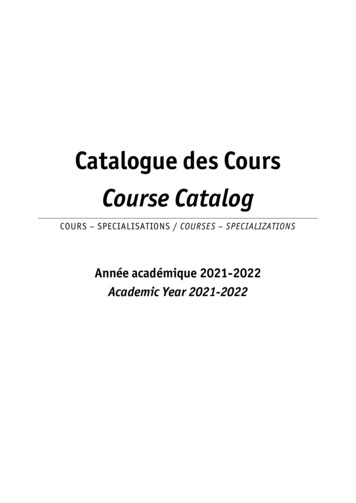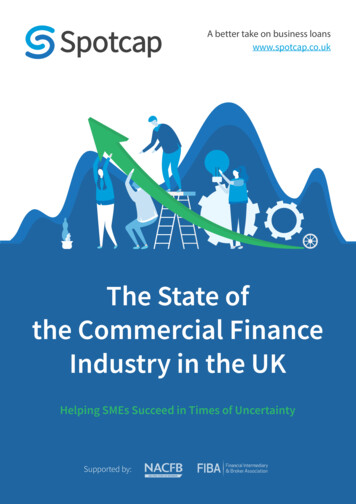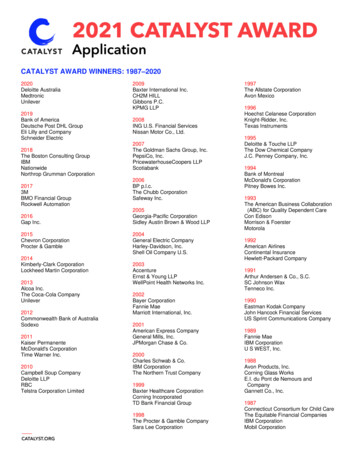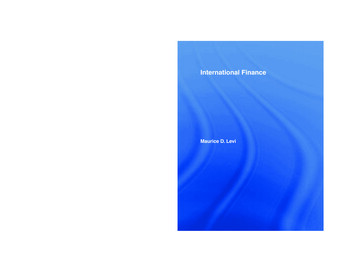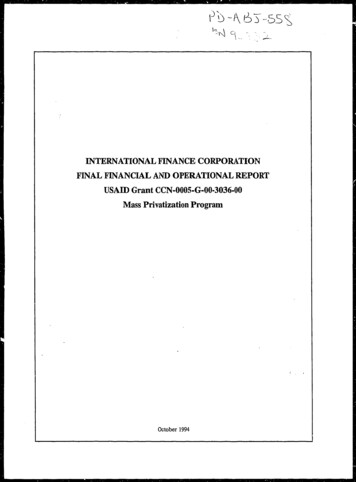
Transcription
INTERNATIONAL FINANCE CORPORATIONFINAL FINANCIAL AND OPERATIONAL REPORTUSAID Grant CCN-0005-G-00-3036-00Mass Privatization ProgramOctober 1994
MASS PRIVATIZATION IN RUSSIAInternational Finance CorporationFinal Financial ReportOctober 1994
ITABLE OF CONTENTSStatement of Cash Receipts, Disbursements and Grant Balance1Financial Report .2Equipment Inventory .5
International Finance CorporationUSAID Grant #CCN-0005-G-00-3036-00 Mass Privatization ProgramGrant Period 15 January 1993 - 15 July 1994Statement of Cash Receipts, Disbursements and Grant Balance(Expressed in US dollars)ReceiptsContributionsInterest income1,625,000.001,625,000.0058,641.15Total receipts3,308,641.15DisbursementsProject disbursements3,220,794.58Excess of receipts87,846.57Grant balance consists of:Cash29,205.42Interest58,641.15Total balance87.846.57
FINANCIAL REPORTGRANT #CCN-0005-G-00-3036-00 MASS PRIVATIZATION PROGRAMUS 3,250,00001.15.9307.15.941.Total amount:Starting date:Expiration date:2.The grant was disbursed to IFC in two sums:US 1,625,000 (receipt on 03.25.93)US 1,625,000 (receipt on 07.19.93)3.The final breakdown of the project costs is the following:Expense CategoryExpensed US 1.Consultant salaries506,394.382.Relocation, monthly housing andtransport allowance128,500.003.Consultant travel245,159.514.Staff travel335,060.725.Consulting companies6.Moscow central306,809.887.Washington coordination172,131.958.Consultants' insurance10,720.40TOTAL EXPENSES3,220,794.58BALANCE1,516,017.7429,205.42
4.Here follows a brief explanation of the expense categories.a.Consultant salaries include salaries of 17 consultants (both long- and short-term,all US nationals) having worked on the project in the course of a year and a half.b.Relocation, housing and transport allowances were paid to long-term consultantsliving in Russia. The allowances were calculated taking COLA adjustments andsecurity issues into consideration.c.Consultant travel includes long- and short-term consultant travel expenses as wellas local operating costs such as translation services, local staff salaries, businesscommunications.d.Staff travel includes the travel expenses of IFC Europe Department investmentofficers who worked on the project - Stephanie von Friedeburg (Rawlings) andVictor Paul, as well as one trip of Europe Department staff member AndrewStaples and travel expenses of 7 other IFC staff members from the legal,corporate relations and engineering departments assisting in the implementationof the project.Travel expenses of Stephanie von Friedeburg and Victor Paul include localoperating costs such as the purchase of computer equipment (see attachedEquipment Inventory), translation services, local staff salaries, apartment rental,business communications, local staff travel and salaries. These costs wereaccumulated in the staff travel category because of internal IFC accounting systemconstraints concerning cash transactions in Russia.e.Consulting companies contracted to work on the project are the following:CompanyBurson-MarstellarDeloitte & ToucheSteptoe & JohnsonAreapublic relationsvoucher auctionlegalPaid 576,838.82 903,420.69 35,758.23f.Moscow central office was set up in the course of project implementation.Moscow central office staff supported project implementation. Expenses incurredinclude local staff travel, local legal companies, local travel, equipment and otheroperating expenses.g.Washington coordination aspect includes support for post-privatization (1 USnational) as well as consultants working on the project in Washington (1 Russian,1 US national). It also includes equipment bought through Washington and sentto the field (Volgograd, Tomsk, Nizhny Novgorod, Yakutsk) and was transferred,together with the equipment bought locally, to local authorities when the work
was finished. (See attached Equipment Inventory.)Consultants' Insurance consists of the health insurance contributions for long-termconsultants.h.The staff members directly involved in the project made a contribution of 181 staff-weekswhich is the equivalent to 1,808,000.DaysContribution n95190,000von 04 days(181 staff weeks)1,808,000NameSullivanTOT\LIn addition to the above, there were other IFC staff members taking part in thedevelopment of the program in the course of meetings, consultations and discussions. Thework of IFC Europe Department support staff was also invaluable. The use of telephone,fax, mail services and other facilities are not included in the above figure and addsignificantly to the IFC contribution.A detailed breakdown of expenses is available. The account where the US 3,250,000 wasmanaged, was audited in November 1993 by Price Waterhouse and is being audited nowby the same company according to the World Bank internal auditing procedures. Inaddition, Earnst & Young was retained at IFC's expense to analyze various aspects ofthe USAJD grant financial management. Results of the audits are available upon request.
Equipment InventoryVolgogradInventoryNumberIItem of EquipmentAT 386 PersonalComputerStock Number ProjectG/H 720500902TR NumberLarge-Scale/ See attached invoiceVolgogradand also see SOE inDate ofPurchasePurchasePriceCurrentLocation02/04/93 2,250Property Fund,Volgograd02/04/93 2,250Property Fund,VolgogradWashington2AT 386 PersonalComputerG/H 720303576Large-Scale/ See attached invoiceVolgogradand also see SOE inWashington3AT 386 PersonalComputerG/H 720304554Large-Scale/ See attached invoiceVolgogradand also see SOE hiWashington02/04/93 2,250Property Fund,Volgograd4Matrix PrinterHyundai HDP-92012167587Large-Scale/ See attached invoiceVolgogradand also see SOE hiWashington02/04/93 300Property Fund,Volgograd5Matrix PrinterHyundai HDP-92012167593Large-Scale/ See attached invoiceVolgogradand also see SOE hi02/04/93 300Property Fund,Volgograd04/22/93400,000 Rbl Property Fund, 1 807 Rbl Volgograd 495Washington6Electronic VoucherCounters MFC-003(2 items)0252 & 0330Large-Scale/ Directly charged toVolgogradTrust Fund, purchasedby Field Office
78Magnetic securer108, 607, 604,detector V1LDIC(5 items)558, 74Laser Printer IBM56-601864029-010Large-Scale/ Directly charged toTrust Fund, purchase dVolgogradby Field Office03/26/93Large-Scale/ Directly charged toTrust Fund, purchasedVolgograd03/24/93177,000 Rbl Property Fund, 1 735 Rbl Volgograd 240 2,150Property Fund,Volgograd 251x3Property Fund,Volgograd 2,288Propertyby Field Office9Back-UPS 600(3 items/920836059,920838690,92084978510IBM PC/2's PersonalW920854274Computerincluding MonitorLarge-Scale/ Directly charged toTrust Fund, purchasedVolgogradin WashingtonLarge-Scale/ Directly charged toTrust Fund, purchasedVolgogradin WashingtonCommittee,Volgograd72-000157IBM 85 12-00411IBM PC/ i PersonalComputerVB55-011YVIBincluding Monitor55-70006Large-Scale/ Directly charged toTrust Fund, purchasedVolgogradby Field Office07/10/92 1,800PropertyCommittee,Volgograd 1,908PropertyCommittee,VolgogradIBM12HP LaserJet III3220J07722Large-Scale/ Directly charged toTrust Fund, purchasedVolgogradin Washington
Nizhny NovgorodInventoryNumber1Item of EquipmentStock Number ProjectAT 386 PersonalComputer2AT 386 PersonalComputer3Computer PC AT 386SX4Printer IBM 40210905Computer PC AT286/2876Computer PC AT286/28756-60189TR NumberDate ofPurchasePurchasePrice02/04/93 2,250Property Fund,Nizhny Novgorod02/04/93 2,250Property Fund,Nizhny Novgorod03/11/93 2,500Property Fund,Nizhny Novgorod03/11/93 2,150Property Fund,Nizhny NovgorodLarge-Scale/ BrowneU, N80739,CaseyT00094NizhnyNovgorod09/27/93 550PropertyCommittee,Nizhny NovgorodLarge-Scale/ BrowneU, N80739,CaseyT00094Nizhny09/27/93 arge-Scale/NizhnyNovgorodSee attached invoiceand also see SOE inWashingtonSee attached invoiceand also see SOE inWashingtonDirectly charged toTrust Fund, purchasedby Field OfficeDirectly charged toTrust Fund, purchasedby Field OfficeNizhny NovgorodNovgorod7Fax Canon 2 70SCurrent LocationLarge-Scale/ Directly charged toTrust Fund, purchasedNizhnyby Field OfficeNovgorod02/04/93 1,260PropertyCommittee,Nizhny Novgorod
YakutskInventoryNumber1Item of EquipmentStock Number ProjectTR NumberDate ofPurchasePurchasePriceCurrent LocationProperty Fund,Large-Scale/ Easter, 20674Yakutsk07/09/93Large-Scale/ Easter, 20674Yakutsk07/09/93AT 286 PersonalLarge-Scale/ Dietrich, 1752607/21/93ComputerYakutskProperty Fund,YakutskMSC, 286 Personal9310123Computer 864Yakutsk9228301011including Wang VGAColor Monitor2MSC 386 Personal4275032493023Computer 1,340Property Fund,YakutskMBWHE2 10304including Hyundai203Super Color Monitor35Smart Link Modems(2 k6VGA Color Monitors(2 items)Large-Scale/Yakutsk7Smart One Modems(2 items)4AT 286 rsonalCompu'3151445,3150941Large-Scale/ Easter, 20674Yakutsk 2,680Property Fund,Property Fund,YakutskProperty Fund,Yakutsk07/09/93 188Property Fund,Yakutsk
8SLT 286 PersonalComputer 26809Printer HP LaserJetnipCanon FC 3 30 Photo10copier3134JWODSPLarge-Scale/ Dietrich, 17526YakutskLarge-Scale/ Dietrich, 17526YakutskPFV04820,F12910007/26/93 1,512Property Fund,Yakutsk07/02/93 2,286Property Fund,Yakutsk
TomskInventoryNumberItem of Equipment1HP LaserJet IIIp2Computer IBM PC/2's34Stock Number Project3128JUOK33PropertyCommittee, Tomsk11/06/92 3,360PropertyCommittee, Tomsk11/06/92 1,450PropertyCommittee, Tomsk02/17/93 1450Property Fund,Tomsk02/17/93Large-Scale/ See attached invoiceand also see SOE inTomskWashington (Tokolish) 2,058Property Fund,Tomskin WashingtonXerox 50 14 Photocopier06U32062 14154 Large-Scale/ Directly charged toTomskTrust Fund, purchasedZ9913035including VGA ColorCurrent Location 2,288Large-Scale/ Directly charged toTrust Fund, purchasedTomskMC20900438Computer IBM PC/38601/20/93PurchasePricePropertyCommittee, Tomskincluding MonitorFax Canon 27OSDate ofPurchase 1,560Large-Scale/ See attached invoiceand also see SOE inTomskWashington (Towers)by Field OfficeLarge-Scale/ Directly charged toTomsk5TR NumberTrust Fund, purchasedby Field OfficeLarge-Scale/ See attached invoiceand also see SOE inTomskWashington (Tokolish)Monitor6Computer IBM PC/386including SVGA ColorMonitor
7Printer LaserJet IIIp8Canon NP 12 15Large-Scale/ See attached invoiceTomskand also see SOE inWashingtonLarge-Scale/Tomsk02/17/93 1,692Property Fund,Tomsk 2,500Property Fund,TomskJ
TABLE OF CONTENTSPART OM,: Executive Summary .1PART TWO: OvemeM'.3Rationale.3Background.3PART THREE: Mass Privatization Program .6PART FOUK: IFC's Approach and Scope of Work .8Introduction. Establishing Resident Teams. 8Building a Pipeline of Enterprises. 9Legal Documentation. 9Enterprise Information Distribution. 11Establishing a Bid Reception or Auction Center. 11Designing and Implementing a Public Relations Campaign.l4Registers of Shareholders, Handbooks and Seminars.l7Evidence of Share Ownership.18Cash Sales.19PART FIVE: Results. IFC Assisted Regions .20Volgograd. Novosibirsk.21Nizhny Novgorod.21Tomsk.21Yakutsk. The Russian Federation.!.22The All Russian Auction System .23Public Education.24Evidence of Ownership.24Regulatory Feedback .24Share Registry Manual.25Regional Depository System .25PART SIX: Conclusions. .27Digrams and AnnexesList of IFC ConsultantsIFC Project Locations
PART ONE: Executive SummaryWith the guidance of Ana'oly Chubais and the Committee on the Management ofState Property (GKI), privatization, particularly large-scale privatization, hasbecome one of the most demonstrably successful economic reforms undertaken inthe Russian Federation since the collapse of the Soviet Union in 1991. At thecompletion of the first phase of industrial privatization in June 1994, nearly14,000 enterprises in 86 provinces and autonomous republics had been privatized.In total, 97.5 million privatization checks, or vouchers, were exchanged for sharesin medium and large Russian enterprises, creating over 40 million new Russianshareholders and placing 17.2 million workers in the private sector.The Mass Privatization Program, the official name for the first phase of industrialprivatization, was designed in mid-1992 by Mr. Chubais and his colleagues and assuch was Russia-specific though it did use elements from other programs underway in Eastern Europe. The objective was to create a privatization scheme whichwould achieve support of the population at large as well as a wide range of political groups, including those of enterprise managers, workers, and local governments. The vehicle by which shares in medium and large enterprises were to besold to the general public was the voucher auction, utilizing the vouchers distributed to all Russian citizens in October 1992. In December 1992, in order todevelop an overall auction strategy, a limited number of enterprises' shares weresold in pilot auctions in Moscow and Vladimir.Immediately following these pilot auctions, with the goal of assisting the Russianauthorities in developing detailed auction methodologies as well as standard procedures and formats for the Mass Privatization Program, IFC began early work inseveral Russian provinces to introduce industrial privatization. IFC's work wasfunded through a grant from USAID.IFC based its approach on the grassroots principles it was using in its small-scale,trucking and land privatization. Resident teams worked alongside local officials,to recognize problems, identify solutions and work to create the local consensusneeded to make privatization happen. IFC teams were established in NizhnyNovgorod, Volgograd, Tomsk, Novosibirsk, and Yakutsk. In addition to assistingin the corporatization process and running the bid reception and processing centers, the resident teams also undertook broad based public relations campaigns ineach region. With the overall goal of giving the participants as full and comprehensive an information base as possible so that the process was fair and transparent.
On February 8, 1993, less than eight weeks after starting work on the project, thefirst voucher auction opened in the IFC assisted region of Volgograd with 20 companies offered for sale. Within a few weeks, multi-enterprise voucher auctionswere taking place in the other IFC assisted regions. By June 1994, when thevoucher scheme ended, IFC had assisted in the sale of over 1,100 medium andlarge enterprises in the five regions where its teams were resident, collecting nearly six million vouchers. This resulted in the transfer of 1.65 million workers intothe private sector. The leading region was Nizhny Novgorod where over 400 companies were privatized.For the two million shareholders created in the regions where IFC provided assistance in voucher privatization, IFC also began work on shareholder education andon systems of share trading and basic shareholder protection. Seminars were heldand manuals distributed that laid out rights and responsibilities, as well as thesimple mechanics, of what it meant to be a shareholder. Share certificates wereprinted and issued and share registry manuals were produced. In the area of corporate governance, the relationship between the shareholder, the board and thecompany's management received particular attention and work in this area is stillongoing.Although the Mass Privatization Program has been completed, the transfer ofmedium and large enterprises from state to private hands continues by othermeans. In addition, attention is now being focused on the restructuring andfinancing needs of these newly-privatized enterprises. For example, following itsgrassroots approach, IFC is sponsoring a regional venture fund which will providefinancing to these companies and has begun management training courses. TheCorporation is also undertaking a capital markets program to assist local brokerdealers in establishing trading practices and in publicly issuing shares in a newly privatized enterprise.
PART TWO: OverviewRationalePrivatization is defined as the transfer of state-owned assets to the private sector.Over the last two decades, it has come to be considered throughout the world asthe most effective method of putting under-utilized state-owned assets into productive use and thereby creating more efficient industries. This move towards private ownership recognizes the fact that state-owned enterprises are inefficientbecause they are often "politicized", or easily incentivized to pursue politicalgoals such as high employment instead of economic goals such as the maximization of profit.Following this logic, Russian authorities determined that the goal of privatizationin Russia should be the depoliticization of enterprises. Although it was recognized that depoliticization in and of itself was not sufficient to make enterprisesfully efficient, it was thought that depoliticization was an essential first step in thetransformation process. Russian privatization was viewed by the authorities notas an end in itself, but rather as a means of transferring control of enterprise cashflows from politicians to managers in order to initiate necessary enterpriserestructuring.It was the politicians themselves that were responsible for establishing Russia'sinitial industrial privatization program, which, by necessity, had to satisfy thedemands of a number of very powerful constituencies including local governments, workers, and enterprise managers. The result was a program which incorporated elements of similar programs enacted in Eastern Europe but which wasquite unique to Russia.BackgroundFollowing the success of small-scale privatization, in 1992 the GKI turned itsattention to the creation of a framework for the privatization of medium and largestate-owned enterprises by which enterprises in this category could be first corporatized, or turned into open joint-stock companies with 100 percent of the sharesbelonging to the government, and subsequently privatized using a combination ofmechanisms including closed subscriptions by workers and managers, investmenttenders, and voucher auctions.As a result of the rationale outlined above and the existing hostile political environment in Russia, especially in the Parliament where the power of the industriallobby was quite strong, the Russian government tailored a unique voucher privatization program rather than fully adopting models such as the Chech-style mutual
fund for several reasons. First, in using vouchers, Russian authorities found away to popularize privatization by involving ordinary citizens directly in theprocess. Second, voucher privatization enabled the authorities to avoid the violentbacklash that would have been the likely result had large shareholders beenimposed on management as a result of a mutual fund scheme. Finally, there was afear that such large shareholders could become easily politicized themselves,thereby subverting the entire process. *The legislative basis for converting state-owned property into open joint-stockcompanies to be privatized under the Mass Privatization Program was provided inthree Presidential Decrees, No. 66 of January 29, 1992 "On Speeding Privatizationof State and Municipal Enterprises," No. 721 of July 1, 1992 "On OrganizationalMeasures to Transform State and Voluntary Associations of State-OwnedEnterprises into Joint-Stock Companies," and the 1994 Privatization Program "Onthe State Program of State and Municipal Enterprises in the Russian Federation."A list of additional relevant privatization legislation appears in Annex One.Under this legislation, any enterprise with book value fixed assets of not less thanfifty million rubles or an employee base of more than 1,000 workers as of January1, 1992 was subject to mandatory conversion into an open joint-stock company,followed by participation in voucher privatization. Companies with less than fiftymillion rubles but more than one million rubles in book value fixed assets orbetween 200 and 1,000 employees could be converted into open joint-stock companies and participate in the voucher process at the request of the workers' collective and the permission of the local property committee. The privatization optionsavailable to enterprises clearly reflect the prevailing balance of political powerand are outlined in Part Three of this paper.In October 1992, 150 million Russian citizens received vouchers throughSberbank, the national savings bank. The vouchers were to be used for the privatization of medium and large enterprises through direct acquisition of shares,investment in a voucher fund, or sale in the secondary market. The cost to eachcitizen was 25 rubles. These vouchers were bearer securities with a watermarkand serial number, a validity period of one year and a 10,000 ruble nominal value.This value represented four months salary in August 1992 rubles.In order to test the voucher framework, develop auction procedures, and todemonstrate the benefits of the program to voucher holders, the Russian authorities organized an auction involving a small number of pilot sales of enterpriseshares using vouchers as the payment mechanism in December 1992. Followingthe successful completion of these pilot auctions, the authorities decided to implement voucher privatization on a wide scale by establishing a "first wave" of public offerings across ten provinces. It was at this time that GKI requested that IFC
and USAID work closely with the local authorities to assist in the "first wave" ofpublic offerings in ten provinces. IFC with USAID funding was to work in fiveprovinces and USAID directly in another five. The chosen IFC provinces wereVolgograd, Tomsk, Nizhny Novgorod, Novosibirsk, and Chelyabinsk.Chelyabinsk was later substituted for the independent Republic of Yakutsk.
PART THREE:The Mass Privatization ProgramThe Mass Privatization Program called for a closed subscription of shares byemployees, in accordance with a privatization plan filed by the enterprise no laterthan October 1, 1992. In order to prepare its plan, each enterprise was required toorganize a working commission, with responsibility for drafting foundation documents and establishing property valuation reports for use in the privatization plan.The privatization plan was then voted on by the workers' collective. There werethree privatization options available to the commission as highlighted below:1.Option One: Employees were given free of charge non-voting sharesworth 25% of the base capital. They were able to acquire an additional 10% of equity at a 30% discount from face value. Finally, topmanagement was able to purchase up to 5% of equity at face value.Each employee could receive no more than an amount equal to sixmonths' wages.2.Option Two: An employee group could purchase 51% of votingshares at a price of 170% of face value. Each employee couldreceive no more than an amount equal to six months' wages.3.Option Three: Employees were allowed a one-year lease on theenterprise with an option to buy 20% of the base capital at 70% offace value at the end of the year in return for "restructuring" theenterprise. This option was limited to enterprises with less than 200employees and was rarely used.All shares not distributed to workers' collectives, generally 49-60%, were madeavailable for open sale. The majority of the open stock was to be sold for vouchers in specialized voucher auctions. Any enterprise with an employee base over10,000 was considered federal property and the sale of the enterprise had to becoordinated with the Federal Fund in Moscow. Under GKI Ordinance No. 308-pconcerning "Closed Subscription to Shares in Privatizing State and MunicipalEnterprises," the Federal Fund was allowed to place shares totalling not more than20% of the shares slated for voucher auction in a specialized voucher auctiontrust. Given much controversy over the percentage of enterprises to be sold forvouchers, a presidential decree was written on May 8, 1993, stating that 29% ofshares must be sold for vouchers through specialized voucher auctions.
Under the OKI plan, a voucher auction model was envisioned whereby enterprisescould be sold to the public through an open, silent bidding process. Each participant in a vouch:,!' auction was to deliver to an auction center an adequately completed application form and corresponding vouchers. There were two types ofbids available to the potential investor, type one and type two, as described below:1.Type One: An unrestricted bid which expressed willingness toinvest in a particular enterprise regardless of the price per share.This bid was designed for the small investor. As an unrestricted bid,it was always met.2.Type Two: A restricted bid in which the investor expressed the price(in shares per voucher) at which he would be willing to purchaseshares in an enterprise. This bid was designed for larger investorsand was satisfied by an equilibrium price .Participants in voucher auctions could be natural persons or legal entities qualified as buyers. Initially, foreign entities were permitted to purchase shares provided that they invested via a wholly owned Russian subsidiary or obtained alicense from the Central Bank and permission from the Ministry of Finance to purchase the share directly. However, the 1994 Privatization Program was changed toallow foreign investors to participate in voucher auctions, subsequently informingthe Ministry of Finance of their actions.In order to test the above voucher framework and demonstrate the benefits of theprogram to voucher holders, in December 1992, the Russian authorities organizeda "model series" of early voucher auctions. In the "model series," there were sixenterprises sold through voucher auctions in Moscow and in Vladimir. The auctions were carried out and helped define a foundation for adequate selling procedures.Following these successful pilot auctions, the authorities decided to implementmedium- and large-scale privatizatio
Laser Printer IBM 4029-010 Back-UPS 600 (3 items/ IBM Personal Computer including Monitor IBM 85 12-004 IBM PC/ i Personal Computer including Monitor IBM HP LaserJet III 108, 604, 558, 74 56-60186 920836059, 920838690, 920849785 W920854274 72-000157 VB55-011YVIB 55-70006 3220J07722 Large-Scale/ Volgograd Large-Scale/ Volgograd Large-Scale .
